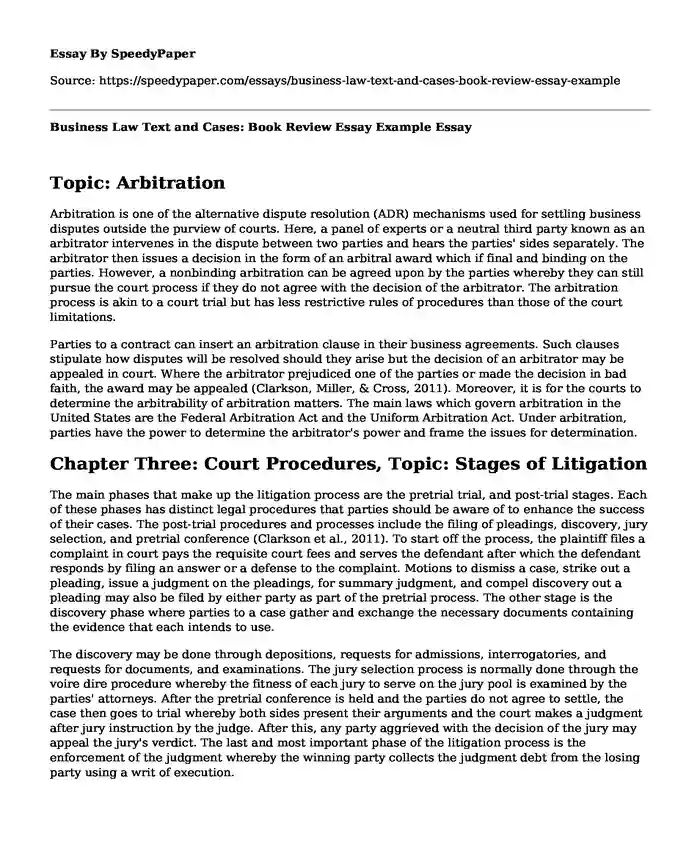
| Essay type: | Book review |
| Categories: | Business law |
| Pages: | 3 |
| Wordcount: | 774 words |
Topic: Arbitration
Arbitration is one of the alternative dispute resolution (ADR) mechanisms used for settling business disputes outside the purview of courts. Here, a panel of experts or a neutral third party known as an arbitrator intervenes in the dispute between two parties and hears the parties' sides separately. The arbitrator then issues a decision in the form of an arbitral award which if final and binding on the parties. However, a nonbinding arbitration can be agreed upon by the parties whereby they can still pursue the court process if they do not agree with the decision of the arbitrator. The arbitration process is akin to a court trial but has less restrictive rules of procedures than those of the court limitations.
Parties to a contract can insert an arbitration clause in their business agreements. Such clauses stipulate how disputes will be resolved should they arise but the decision of an arbitrator may be appealed in court. Where the arbitrator prejudiced one of the parties or made the decision in bad faith, the award may be appealed (Clarkson, Miller, & Cross, 2011). Moreover, it is for the courts to determine the arbitrability of arbitration matters. The main laws which govern arbitration in the United States are the Federal Arbitration Act and the Uniform Arbitration Act. Under arbitration, parties have the power to determine the arbitrator's power and frame the issues for determination.
Chapter Three: Court Procedures, Topic: Stages of Litigation
The main phases that make up the litigation process are the pretrial trial, and post-trial stages. Each of these phases has distinct legal procedures that parties should be aware of to enhance the success of their cases. The post-trial procedures and processes include the filing of pleadings, discovery, jury selection, and pretrial conference (Clarkson et al., 2011). To start off the process, the plaintiff files a complaint in court pays the requisite court fees and serves the defendant after which the defendant responds by filing an answer or a defense to the complaint. Motions to dismiss a case, strike out a pleading, issue a judgment on the pleadings, for summary judgment, and compel discovery out a pleading may also be filed by either party as part of the pretrial process. The other stage is the discovery phase where parties to a case gather and exchange the necessary documents containing the evidence that each intends to use.
The discovery may be done through depositions, requests for admissions, interrogatories, and requests for documents, and examinations. The jury selection process is normally done through the voire dire procedure whereby the fitness of each jury to serve on the jury pool is examined by the parties' attorneys. After the pretrial conference is held and the parties do not agree to settle, the case then goes to trial whereby both sides present their arguments and the court makes a judgment after jury instruction by the judge. After this, any party aggrieved with the decision of the jury may appeal the jury's verdict. The last and most important phase of the litigation process is the enforcement of the judgment whereby the winning party collects the judgment debt from the losing party using a writ of execution.
Chapter Four: Constitutional Authority to Regulate Business, Topic: Commercial Speech
Commercial speech entails marketing and advertising communications by business organizations for their own commercial interests (Clarkson et al., 2011). The protection of such communications by the First Amendment is less extensive compared to the noncommercial speech. The First Amendment's protection of commercial speech notwithstanding, states are permitted to place restrictions on business adverts. An example is where it is in the interest of consumers to ensure they are protected from misleading or obscene product promotions. Billboard advertising by businesses may also be regulated by the state since they have a legitimate interest in the beautification and safety of roads.
According to Clarkson et al. (2011), for a restriction on commercial speech to be valid, it must meet certain criteria. The first criterion is that a substantial government interest must be sought to be implemented by the restriction. The other factor is that the restriction has to advance the interest directly and not go overboard in accomplishing its desired objective. Hence, business firms should know which commercial speech is protected and which is not protected as they engage in product promotion activities. Business communications which malign other businesses, promote obscenity, go against public policy or morals, or advance a violent or illegal course do not enjoy protection under the Fourth Amendment.
Reference
Clarkson, K.W., Miller, R.L., & Cross, F.B. (2011). Business law text and cases: Legal, ethical, global, and corporate environment. Mason: OH: South-Western Cengage Learning
Cite this page
Business Law Text and Cases: Book Review Essay Example. (2022, Sep 06). Retrieved from https://speedypaper.com/essays/business-law-text-and-cases-book-review-essay-example
Request Removal
If you are the original author of this essay and no longer wish to have it published on the SpeedyPaper website, please click below to request its removal:
- What Are General Education Competencies? The Answer in This Free Essay
- Computer Information Systems Essay Sample
- Free Essay Sample about Uninsurable-risk Traps
- Free Paper Sample about Government Intervention in Economic Development
- Essay Example about Emerging New Technologies in The Next Five Years
- Cochrane - Article Review Essay Example
- Essay Sample on Improving Personal and Organizational Communication
Popular categories




